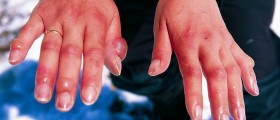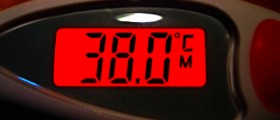Almost all people know that the normal body temperature is 98.6 degrees Fahrenheit. On the other hand, not everybody knows the fact that the body temperature changes during the day. Factors like the time of the day and the activity level influence the body temperature. It is normal for the temperature to change as much as one degree above or below the normal body temperature. In most cases, the temperature is lower early in the morning and somewhat higher in the afternoon. Usually, the body temperature shows how fast a person's metabolism is.
Thermoregulation is the mechanism that maintains the normal body temperature in the body. When a person feels cold the flow of blood to the skin is reduced. In this way the heat is conserved and the body is able to maintain the normal body temperature. When a person feels cold, the blood vessels will spread. This way a person will sweat which will enable the body temperature to get back to normal. However, there are certain conditions that can impair this normal mechanism, and then a person's body temperature will rise or fall.

- In this study, we analyzed 677,423 human body temperature measurements from three different cohort populations spanning 157 years of measurement and 197 birth years. We found that men born in the early 19th century had temperatures 0.59°C higher than men today, with a monotonic decrease of ?0.03°C per birth decade. Temperature has also decreased in women by ?0.32°C since the 1890s with a similar rate of decline (?0.029°C per birth decade).
- We observed similar temporal change within the Union Army Veterans of the Civil War cohort (UAVCW) cohort—in which measurement were presumably obtained irrespective of the subject's birth decade—as we did between cohorts. Additionally, we saw a comparable magnitude of difference in temperature between two modern cohorts using thermometers that would be expected to be similarly calibrated.
- Resting metabolic rate is the largest component of a typical modern human’s energy expenditure, comprising around 65% of daily energy expenditure for a sedentary individual.
- Heat is a byproduct of metabolic processes, the reason nearly all warm-blooded animals have temperatures within a narrow range despite drastic differences in environmental conditions. Over several decades, studies examining whether metabolism is related to body surface area or body weight.
- Although there are many factors that influence resting metabolic rate, change in the population-level of inflammation seems the most plausible explanation for the observed decrease in temperature over time.
Below Normal Body Temperature Causes
A slight change in the body temperature is rather normal and a person should not worry if that happens. But if the temperature of the body goes below 95 degrees Fahrenheit or 35 degrees Celsius a person should know that it is then a potentially severe medical condition. Hypothermia is a condition when a person's body temperature is a lot lower than normal. Hypothermia occurs when a person is exposed to extremely cold weather for a long period of time or is not properly dressed in the winter or simply falls into cold water. In some cases, hypothermia can even be lethal.
Infections are known to cause the fall of body temperature in infants and elderly people. A severe infection can even lower the body temperature in adults. In serious cases, a person may go into a septic shock. There are other causes of low body temperature like an underactive thyroid gland, metabolic disorders, nutritional deficiencies, alcohol abuse, and many others.
Below Normal Body Temperature Symptoms
The most obvious symptoms of low body temperature are shivering and pale and cold skin. If the condition worsens a person may experience slow heartbeat and breathing, mental confusion, drowsiness, weakness, loss of coordination, and purple fingers and toes. Cardiac arrest and shock may occur if the condition is not treated.
Treatment for Below Normal Body Temperature
It is important that the underlying cause is discovered. More severe cases need medical attention. Until medical help is available a person should cover up with blankets in order to preserve the heat. Hot fluids also help. Prevention of hypothermia is important and a person can easily achieve that.

















Your thoughts on this
Loading...